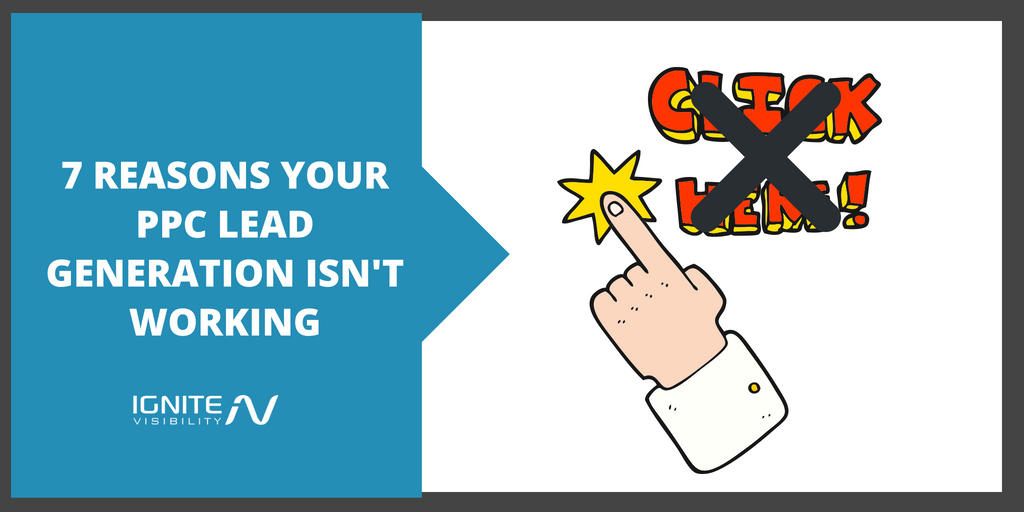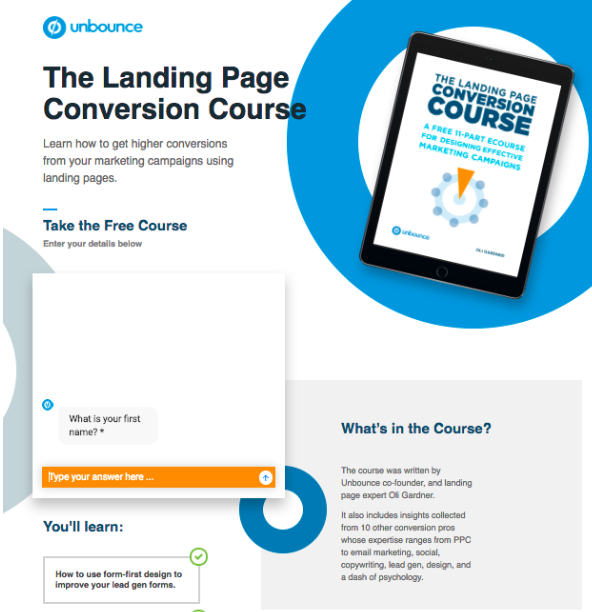PPC is one of the most effective channel for lead generation.
Why? Because it quickly puts you in front of the audience you need.
That said, it’s not the easiest channel to get right. In this article, I’ll take you a through a few reasons why your PPC lead generation may not be delivering.
-
Your Intent Doesn’t Match Your Channel
It’s easy to think of PPC as a one-size-fits-all strategy.
But when deciding how to allocate your budget, it’s important to take into account your overall goal – and which channel will get you there.
For example, PPC in AdWords is separated into the Search and the Display network.
Search is arguably the more famous of the two, but it isn’t necessarily the best if your goal is brand awareness.
The search network caters to people looking for quick solutions and high purchase intent. For example, if your air conditioning goes out on in the middle of a heatwave, you’re searching Google for a repairman right away.
The Display network, on the other hand, is far more passive. These ads pop up on sites all over the web, and the people that see these ads haven’t actively been searching for them.
Instead, they’re strategically placed on sites that align with a users interests and search habits, making them ideal for brand awareness.
While both can (and should) be used for lead generation, your industry and services offered will play a large hand in which network best suits your needs.
Think about your buying process. Do people tend to make quick decisions, like an AC repairman, or is the process usually more drawn out like, say, a high-end car retailer?
In the car retailer’s case, it may be most beneficial to first use a search ad for initial discovery, and then show remarketing ads across the Display network.
The lead will be exposed to your ad, but because they aren’t making a snap decision, you’ll continue to nurture the lead through the Display network and, if all goes well, eventually convince them to take the desired action.
Because the ads serve audiences with different intent, it’s important that the creative of your ad match it, as well as your landing page.
-
You’re Ignoring Your Landing Page for PPC Lead Generation
Okay, ignoring may be a bit harsh.
But all too often, companies don’t put the emphasis they need on developing a high-quality landing page.
Think about it: your ad is really just the gateway to your landing page. It needs to be enticing enough to earn the click, but what they land on after has to seal the deal.
Generally, your ad won’t lead back to your homepage. Instead, it leads to a highly targeted page designed with the right amount of text, images, and strong CTAs to make the lead take action.
Focus first on your value proposition. If you want a lead to engage, they need to first be totally convinced that whatever they’re doing – submitting a form, making a phone call, etc. – is worth it.
Take a look at this landing page from Unbounce. Not surprisingly, they do a pretty great job.
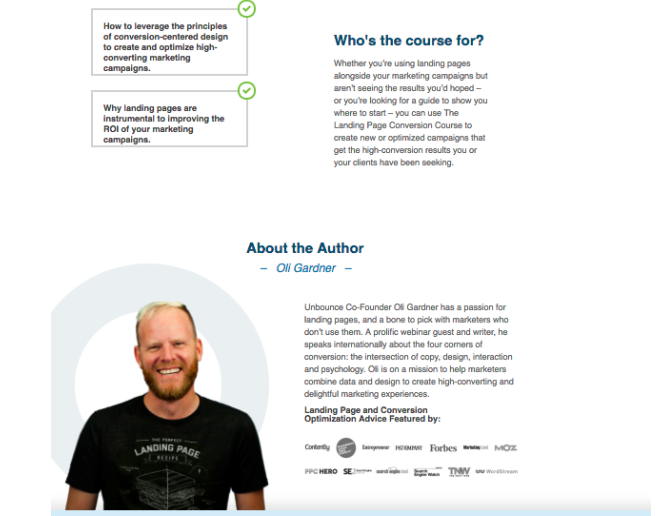
Unbounce’s landing page for PPC lead generation
There are a couple things they did really right. First, they very clearly state what they’re offering and who will benefit from it.
And, they use a more innovative and inviting way to collect lead information – through a chat box, not your usual form.
Unbounce also found a way to include all the relevant information in a way that doesn’t seem clunky or overwhelming. Remember, design is very important when it comes to landing pages; they should be simple and designed to quickly and easily convert leads.
You can also focus on showing off your product, like Muzzle does.
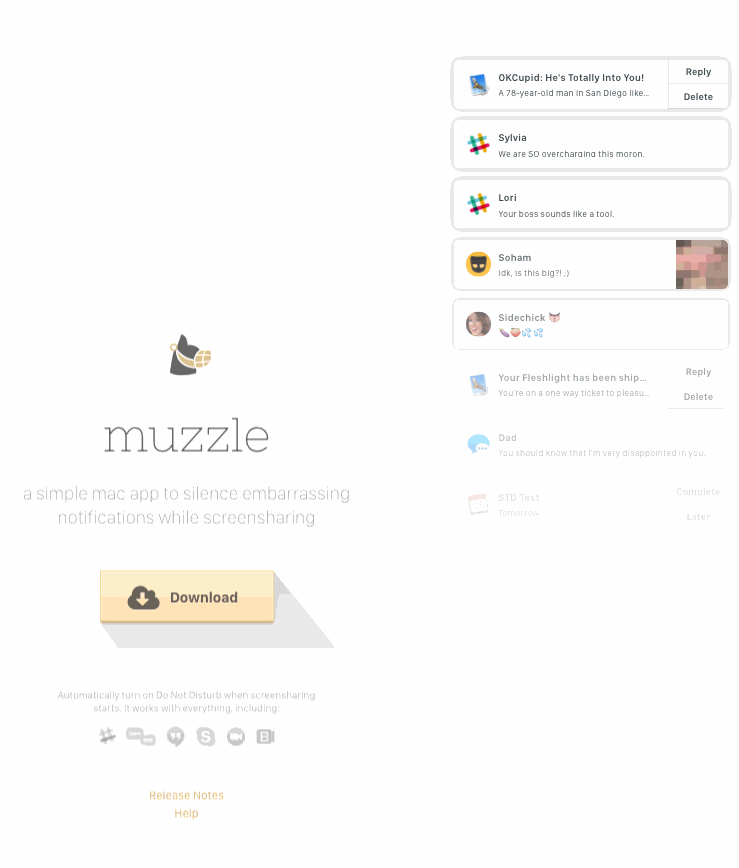
Muzzle landing page for PPC lead generation
It’s an app designed to silence notifications on your Mac screen, and shows off exactly how useful it is through animation. No explanations needed.
And of course, when designing a landing page connected with a PPC ad, make sure the two are completely aligned in purpose. Anything you promise in your ad must be delivered and expanded on in your landing page.
Otherwise, your leads will feel misled, and you’ll see a sure spike in bounce rate.
Make sure your landing page is mobile friendly.
-
You’re PPC Lead Generation Campaign is Targeting the Wrong Keywords
Without a little time and practice, this one’s pretty tough – especially when handling a client’s keywords for their PPC campaign.
See, to really get the most out of your keywords, they need to convert well, provide a high ROI, and match the products or services that your client provides.
Which is why it’s beneficial to include them in the keyword stage.
Do your keyword research as usual and gather a big list of potential keywords. Then, go through it with your client to refine the list to the most relevant ones to bid on. They can tell you which ones point to services that are most likely to make them the most profit.
Also, don’t limit your keywords to short tail. Doing so will likely result in you spending more money for a lesser return.
Instead, try to gather as many longtail, descriptive keywords as possible. For the record, a longtail keyword is anything four words or longer.
Why are they so important? Just look at the graph below.

Longtail vs. short tail keywords for PPC lead generation
As you can clearly see, longer, more descriptive phrases have a lower cost and risk associated with them, and provide a higher probability of conversions.
Because longtail keywords are much narrower, they have less competition and are more likely to generate quality leads.
They can also help you tailor your landing page. Instead of running a campaign with the keyword “womens clothes” and linking to a broad landing page, you can tailor your ad and landing page to those looking specifically for “red calvin klein women’s dress.”
-
You’re Only Using Broad Match for Your PPC Lead Generation Campaign
Because we’re talking keywords, let’s take it a step further.
Obviously, it’s important to pick the right keywords in order to show your ads to those – and only those – in your target market.
But, this being American English, every keyword comes with a variety of synonyms, spellings, and variations associated with it.
And you don’t want to miss out on a lead because they left out a comma, do you? Of course not.
That’s why AdWords has keyword modifiers: broad match, exact match, phrase match, and broad match modifier.
For our purposes, we’re focusing on the broad matches.
Broad match alone allows ads to appear to anyone that uses synonyms, misspellings, related searches, and other relevant terms, and is the default setting for any AdWords campaign.
But using broad match modifier, you can require that a certain word be used in a searcher’s query. To signal which words, you simply put a + sign in front of the ones you want to be required.
If that doesn’t sound like a big deal to you, it should.
Not only does it provide greater control over your bid costs, but it allows you to target in on a narrower audience.
Let’s say you run a hotel in Hawaii and want to capture traffic for the following terms:
- Hotel in hawaii
- Budget hotel in hawaii
- Kid-friendly hotel in hawaii
- Book a hotel in hawaii
Because the common terms in each query are hotel and Hawaii, those are the two you would add + signs to signal broad match modifier.
That way, you can still capture plenty of traffic and variations, without having to bid on as many keywords.
In ads where you hope to get a direct response, like PPC lead generation campaigns, broad match modifier is generally your best bet because it allows you to filter traffic into very targeted ad groups.
-
Your PPC Lead Generation Doesn’t Follow the Buying Cycle
I think it’s fairly safe to assume we’re all familiar with the sales cycle.
First, you’ve got awareness, and it funnels all the way down to sales.
And here’s the thing about the sales cycle: it informs exactly how you market to customers.
What level of the cycle you’re targeting will have a hand in your text, offers, CTAs, images, everything.
So when creating a proper PPC lead generation strategy, you have to start out knowing your target audience is at the bottom of the funnel, awareness stage.
Generally speaking, a new lead hasn’t had much – if any – contact with your business. PPC can be a great way to very quickly get your business in front of your target audience.
But once there, you need to speak the lead gen language.
Let’s look at an example. Here are two CTAs:
- Buy now!
- Click for more information
Which one sounds more sales-y? You guessed the first, right?
That’s because the first is more insistent, and assumes that the user is ready to take the plunge.
The second, on the other hand, is designed to gently lead the user to a better resource. Hopefully, your ad image and text has already captured their interest, and while they may not be ready to buy, they are willing to learn more.
The same is true something like the following:
- 20% off today
- Get a quote
See?
When it comes to obtaining new leads, every last detail counts. Make sure that every part of your ad and landing page speak to new customers. Tell them the benefits, but don’t push the sale.
If you’ve done your job right, that part will come later.
-
You’re Not Using Remarketing in Your PPC Lead Generation Strategy
The downside of digital marketing: people rarely take the conversion action you want on the first go around.
But those potential leads who leave your site aren’t lost. They’re still leads, and they need to be nurtured.
Cue remarketing – a marketer’s way to identify and track visitors to their site, and later serve them ads.
And if you aren’t using remarketing (also called retargeting) in your strategy, you’re missing out on a sea of potential leads.
Consider this: the click-through rate (CTR) of a retargeted ad is 10 times higher than the CTR of a typical display ad.
To properly remarket for a PPC lead generation campaign, you’ll want to target the visitors who have visited your dedicated landing page. You can do that using dynamic retargeting.
These ads can be tailored to specific products or services they’ve viewed on your site. So if they visited your landing page that featured an ebook, you can show them an add that aligns with that product.
You can also break your remarketing audience down even further. So, for lead generation remarketing, you could segment by:
- The number of times they’ve visited your site
- The amount of time spent on your site
- Demographics
- Goal completion
Setting up the segments is easy in Google AdWords. Just navigate to your Audience Definition tab and click Create New.
There, you can divide your audience as you like. For example, you could create an audience for people users who have visited your site at least twice and spent at least three minutes on it.
You know that these users are interested in what you’re offering, they just need a little nudge in the right direction. Remarketing delivers.
Just remember, don’t keep serving users the same ads over and over. You want to continuously attract their attention, and you can’t do that showing the same ads.
-
Your PPC Lead Generation Ads Don’t Include Any Ad Extensions
If you aren’t using ad extensions, you aren’t making the most of your ads.
Google says it best here:
“By adding more content to your ad, extensions give your ad greater visibility and prominence on the search results page. That means you tend to get more value from your ad. Extensions often increase your total number of clicks, and can give people additional, interactive ways of reaching you—as with maps or calls.”
So what are ad extensions? They’re bits of added information meant to enhance your ad.
Normally, an AdWords ad includes only a headline, short description, and URL. But extensions allow advertisers to include additional information like contact number, location, and review rating.
They’re great for lead generation because they allow you to give new leads as much information as possible, right there in your ad.
Take, for example, the price extension.
Now, normally this is a great option for highlighting different goods and services and linking directly back to the product page.
But, for lead generations (especially in the B2B space), it can be used in a really unique way.
Let’s take a look at what Wordstream’s done.
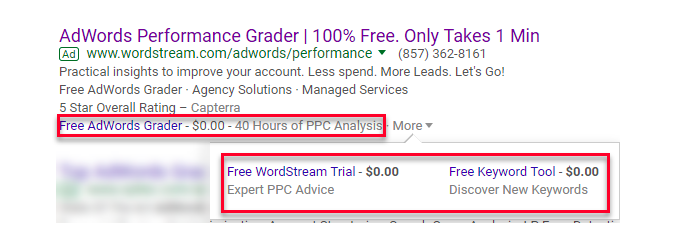
WordPress ad extension for PPC lead generation
Instead of listing out their services and respected prices, they used a price extension to reinforce the fact that AdWords grader is free.
And to a new lead, what price is better than free?
Other extensions like message and call out extensions are also particularly useful for lead generation campaigns.
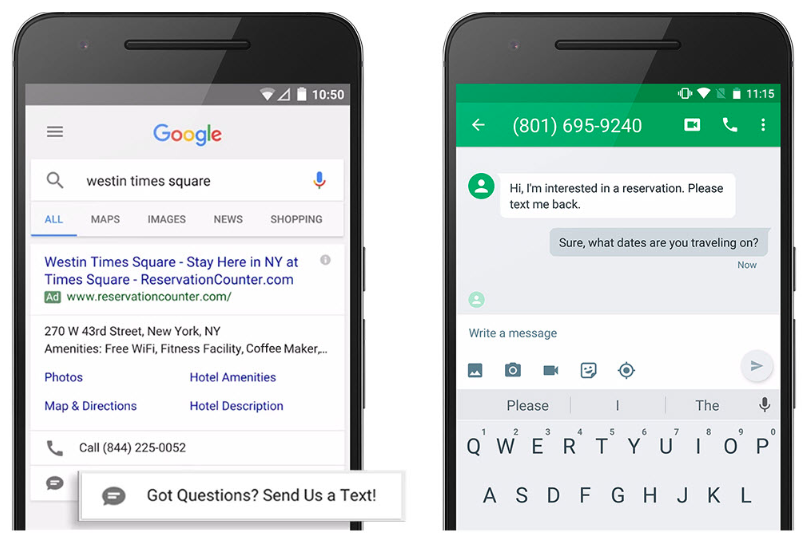
Message extension for PPC lead generation
And of course, nothing puts a lead’s mind at ease better than some reassurance from satisfied customers, which you can provide in the form of rating extensions.
All of these are designed to make the user feel more confident about your business and make the desired action (call, download, for submission) as easy as possible.
Conclusion PPC Lead Generation
I’ll be honest, there’s a myriad of reasons why your PPC lead generation may not be working.
Often times, it’s simply because your overall creative isn’t appealing to your target audience. But if you’re doing the basics right and still find your leads lackluster, you may want to consider some of the above reasons.
